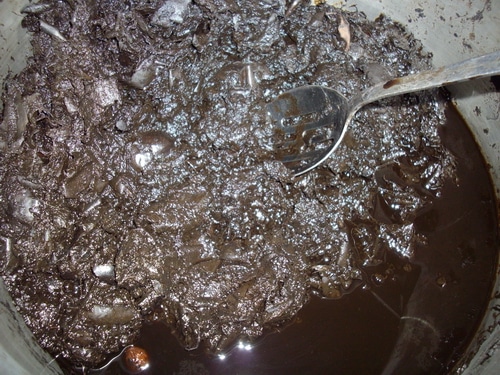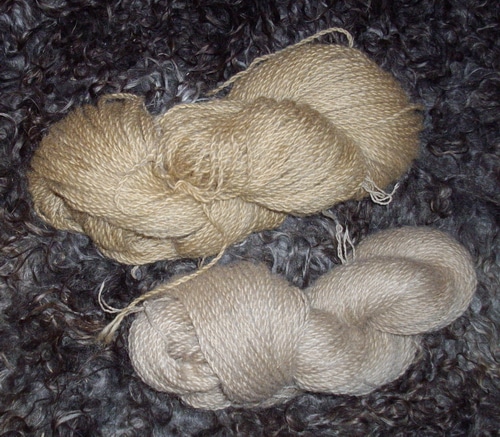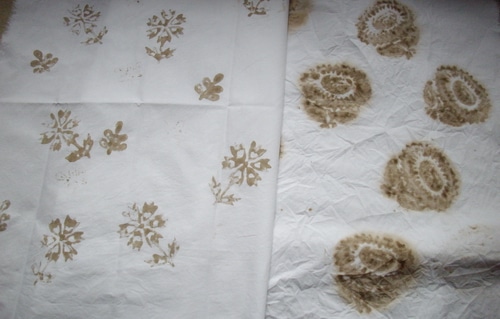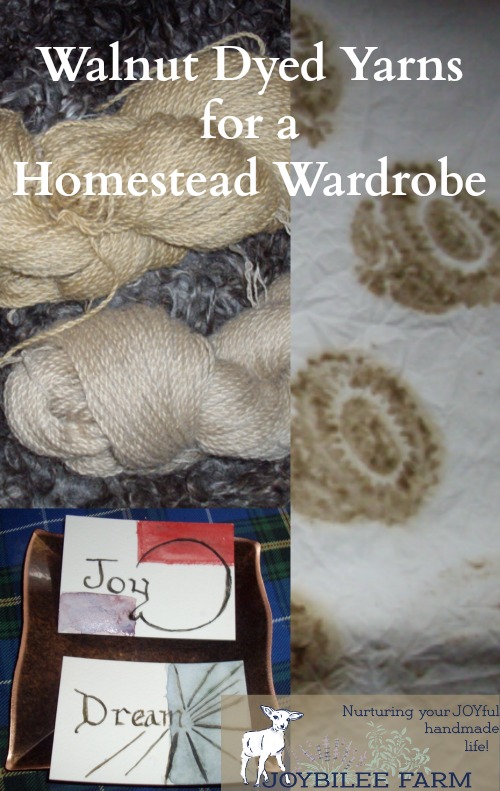Using Natural Walnut Dye Yarns to Colour your Homestead Wardrobe.
Learn how to dye yarns or fabrics with walnut dye. With walnut dye, you do not need to premordant fabric, yarn or wool before dyeing.
In another blog post, I talked about making ink from walnut hulls for fabric printing, or for writing with a fountain pen. In this article, I will show you how to dye yarns or fabrics with natural walnut dye, so that you can create a personal homestead wardrobe.
I took the same walnut hulls that I used to make the walnut extracts for ink and added water to the pot again. If it gets a bit moldy because it took a while before you got around to the dye bath, just skim the vat before you start.

1. Simmer the walnut hulls for several hours.
To make natural walnut dye you’ll need to simmer the walnuts for several hours. I put mine on the back of the woodstove.
The smell is not nauseating so you can do this indoors, or out. Some natural dyes are quite nauseating as they cook and you don’t want to do it indoors. Woad is one of these. But I find walnuts quite pleasant smelling. If you are allergic to nuts or have a family member who is, though, don’t do this in the house. If you personally are allergic to walnuts don’t do this at all! But you can apply these same principles to other natural dyes.

2. Strain the resulting liquor.
It will be quite thick and dark, even though you’ve already taken out a good bit of colour for the ink. You want to strain out the sludge. I like to strain it once. Let it sit for a week so the rest of the sludge drops to the bottom of the pot and then strain it again. If left with sludge in your dye pot, the fabric or yarn that sits in the sludge will streak darker than the rest of the yarn or fabric. If you want this effect, don’t strain it the second time.
3. Prepare yarn or fabric for walnut dyeing.
Before dyeing, you need to scour the fabric with a detergent or washing soda to remove sizing, starches, bleach residue or spinning oils, to prepare the fibre for dyeing. You do not need to dry it after cleaning, but if you do, allow it to soak for several hours before immersing it. If you are dyeing yarn, skein the yarn and tie it loosely in at least 4 places. If you are dyeing loose wool fleece, prepare the fleece by washing gently to remove dirt, lanolin and sweat before dyeing.
With walnut dye, you do not need to premordant fabric, yarn or wool before dyeing. If you choose to premordant you will pick up other colours from the dye vat than if you don’t mordant. You may find that the yarn that is mordanted is more colourfast (or less colourfast) than unmordanted yarn.
I use 3 tsp. of alum and 1 tsp. of cream of tartar for each lb. of wool, silk, or mohair (protein fibre) that I am going to dye. If I am dyeing cotton fabric, with walnut dye, I would not bother to do a second tannin mordant, but with other dyes I do. I use the same amount of alum for cotton or linen, as I do for wool, but I omit the cream of tartar.
If you are dyeing yarn and you want a two-tone effect for knitting or weaving, try mordanting half your yarn and leaving the other half unmordanted.

4. Immersion walnut dyeing
Enter the prewetted fabric, yarn or fleece into a cool vat and put it on your heat source. Slowly bring the vat up to temperature but do not allow it to boil. Simmer it gently, keeping the vat at around 180F for several hours. You can check the colour after a few hours. You want the colour to be darker than what you hope your final product will be because the colour lightens as it drys. Once you have achieved the colour you want. Allow the fibre or fabric to cool in the vat overnight.
5. Rinsing your walnut dyed items
Remove the fibre, fabric, or yarn from the cooled vat. Rinse in cool water, so as not to felt it. Rinse it thoroughly, as many times as necessary to remove all colour that hasn’t adhered to the fibre. The final rinse should be clear. If you are dyeing a fibre that felts easily, like wool, be careful to keep the rinse water at the same temperature, as sudden temperature changes can felt your work, and handle it gently so as not to felt it.
You can spin out the fabric or wool in your washing machine on the spin cycle, but only if your machine allows you to do so without spraying water, during the spin cycle. You can also use a salad spinner or put it in a pillowcase, go outside, and whirl it around your head to imitate a centrifuge. Make sure there are no people nearby to be sprayed.

6. Air dry
You want to air dry it rather than using a clothes dryer. I have a baker’s rack that I spread the fleece out on, beside the woodstove. If you are drying fleece, you want to stir it up as it dries so that it dries evenly.
7. Getting more colour from the walnut dye vat.
That’s it. With natural dyeing, you won’t be able to completely get all the colour from your dye bath onto your yarn, as you do with chemical dyes. Natural dyes contain chromophores but they also contain other natural flavonoids and alkaloids that colour the water but won’t necessarily adhere to yarn. However, you can use the dye bath again for paler shades of the same colour. My favourite way to use up a dye bath is to stuff it with washed fleece and let it sit for a week in a cool place. Then simmer it just before removing the wool. This pretty much uses up all the colour that’s left in a dye vat. If the shade is pale, it can be used as an under dye for another dye vat. Walnut is a very good under dye to get dark almost black blues from woad and indigo.

A friend of mine from the UK, makes handmade paper, for bound books and cards. She takes these second dye vats and puts shredded paper and bits of fabric and thread in them. Once she has cleaned out the vat, she turns the scraps into beautiful handmade papers and books.

Natural Dyes Resources:
The Modern Natural Dyer
Wild Colour
Harvesting Color
A Garden To Dye For

Other posts with natural dyes
Walnut ink for fabric stamping
Planning your natural dye garden
Medicinal Herbs that are also Natural Dyes



Hi, I wonder if you know how to dye paper with black walnut extract, as I can find the black walnut as such, I got some of the brown walnut but it is quite hard to get the skin of it which is the one who stains and not the shell.
I bought the extract and need some guidance on how to do it.
Thanks for your help.
Kind regards
Tazio Zaffarone
London
Thanks for sharing your experience, Marilyn. Nice to know how much black walnut grows. I planted one about 8 years ago but it is only about 8 feet tall now. I’m not sure that it will give us nuts in my life time. My hulls come from a friend at Christina Lake who has English walnuts planted by her grand father 80 years ago.
We have black walnut trees and I have used them for dye vats. The dyes I get are from dark brown to almost black, and rosy browns and all shades in between. The trees themselves are hugh, although we planted them only about 25 years ago. Easily 50 feet with almost as much span. The nuts cover the ground underneath to a depth of about a foot and nothing growns but new tree shoots every year. If I want to make a dye vat I pick up the nuts in clusters as they fall in the fall. Then place them in a plastic bucket and leave to freeze and thaw. Around January you can pour the tar like liquor off of them. Dilute it really well or it will make your wool sticky. I have premordanted with alum, also use spareingly. Do not plant one of these tress anywhere where you want anything else to grow, or to be mowed under. Made myself intolerant of all scents by natural dyeing, so now do anything natural outside in the summer. Excited to try it for inks as I have been taking some printmaking courses.